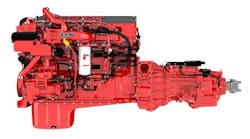I once worked with a guy who was OCD in THE EXTREME.
An example: On a trip one time, the old backpack he carried with him when he traveled finally wore out, and we stopped into a sporting goods store so he could buy a replacement.
A bit later, we stopped for lunch, and I watched in utter stupefaction while he pulled the instruction manual for the backpack out and thoroughly read through it while cross-checking and preparing the backpack for use.
He read the instruction manual. For a backpack.
I still can't believe it. I mean, I can't be certain, but I'm pretty sure I mastered Backpack Technology sometime around 1971.
But hey – we're all different, right?
Like the old male stereotype, I've never been great with reading instructions. (I'm pretty good with following instructions – but that's an entirely different matter.) I learned about the importance of following instructions building model airplane kits as a kid. My first few attempts – in which I merely kinda-sorta glanced at the diagrams as I went to work – didn't turn out all the great. One early effort was an F-4 Phantom Jet – my favorite airplane at the time. I was almost done building the kit, and I put the rear stabilizers (the little wings on the tail of an airplane on) and found they had a distinct downward angle. Well, I just knew this was wrong! Everyone knows wings just stick straight out on airplanes (F4U Corsairs notwithstanding)! So I kept fiddling with the parts, trying to make them fit like I thought they should – and ended up breaking the damn things.
And, of course, if I'd studied the assembly directions for all of 30 seconds, I'd have learned that, yes: The F-4 Phantom's rear stabilizers were designed with a sharp downward angle to help with maneuverability.
All of which brings me to this question: Have your drivers read the instruction manuals for any automated manual transmissions (AMTs) you're asking them to use out on the road today?
It's understandable if they have not. After all, freight has got to move. And besides, AMTs are "idiot proof," right? They're so simple anyone can drive one.
AMT's are, in a sense, much simpler to operate than the old heavy-duty manual gearboxes, that is true. But unlike automotive automatic transmissions, which essentially do one thing (although they do it very well) most AMTs on the market today are jam-packed with extra features which are designed to deliver outstanding performance on par with manual gearboxes in all terrain conditions – on-highway, and off.
All AMTs can be easily operated just like a manual, with the driver physically selecting the preferred gear when they want to shift. This is a highly intuitive process that comes naturally to anyone who's ever driven both a manual and an automated transmission of some type.
Other features are not as easy to identify, unless the driver has taken the time to read the manual and familiarize themselves with how to operate them.
Take Volvo's excellent I-Shift, AMT, for example has basic "Economy" and "Performance" operating modes that drivers can select. There's also a "Kick Down" detent on the accelerator to grab a lower gear in passing situations, as well as a variety of engine brake settings that can optimize performance and fuel economy on downgrades. There's also an "Assisted Launch" which allows drivers to rev the engine up and then get the vehicle moving with a concentrated, and coordinated burst of horsepower and torque -- ideal for off-highway conditions or 6x2 drivetrains in iffy road conditions.
Likewise, Detroit's DT12 AMT has a similar array of driver-help features, including "eCoast" and "Creep" modes, a choice of Performance or Economy operating modes, and kick-down gear. There's also a Hill Start aid, and various cruise control settings that allow drivers to tweak high- and low- speeds while in hilly terrain.
Most of these features operate seamlessly, regardless of AMT make or model. But there's no doubt that a few minutes with the operator's manual or driver card can be a big boost to AMT performance – and driver satisfaction – out on the road. YouTube is loaded with demonstration videos on AMT features and operations. Some fleets are even producing their own videos and making them available to drivers.
The point here is that while assuming AMTs are simple and "anyone can operate them" is a safe bet, you can easily squeeze even more productivity out of these units with a minimal amount of additional education or training. It's an easy investment that can pay fleets big dividends in driver retention and vehicle performance.


